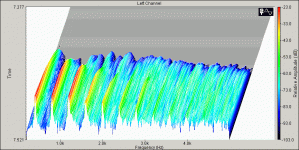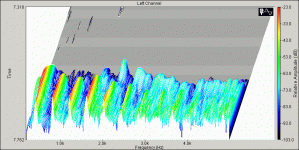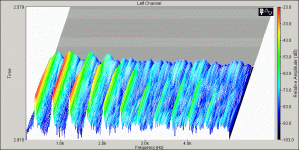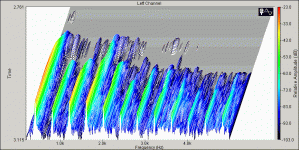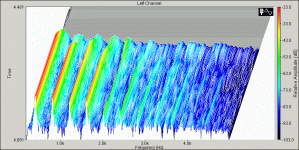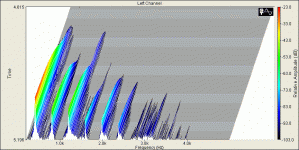OK, back to the "loose ends".
I "believe" - kind of - the contrary here:
There ought to be sufficient phase coherence in the direct sound first, however the room reflection's properties may be in a given loudspeaker/room setup.
And i feel backed by "common listening experience" and also the studies concerning "listener preference" conducted by Toole:
But were the so-called "phase coherent" loudspeakers really preferred by Toole's listening panels? I can't remember.
Having "all early reflections" - as you say it - closely resembling the direct sound, this means they have also nearly the same spectral content.
basically resembling in time domain - this is what I say.
To me it would be sufficient to say "the spectrum averaged over the first N reflecions should approximately resemble the spectrum of the direct sound"
Well, but this relates the whole reverberant field sound to the direct sound and integrates them both as one sound experience - and of course reverberant field sound can colour the sound.
But what about a particular reflection? Are there any requirements that have to be met for the precedence effect to work in this regard? Or is it that just any reflection is caught by the effect? But then - how our ear-brain "knows" that a particular air pressure variation is caused by a reflection and not just another independent sound event?
If:
postulating reflected impulses to be "identical" or "very closely related" to the direct sound, seems overdone and also impractical for the underlying perceptive mechanism to be of use for orientation in real acoustic environments.
if not "basical similarity" then what else can our ear-brain use as a cue?
The Shinn-Cunningham paper shows to me, that "identity" in spectral content is not needed - in a leading and a following binaural pulse - for the precedence effect to occur.
Yes. But don't these very results point to the necessity of another cue?
What could it be? Can't it be ...basic similarity in time domain perhaps? After all as test signals noise burst generated by the same generator and differing only in their center frequency (450 Hz vs 1250 Hz) were used.
Stereo is actually based on summing localization, nevertheless we want room reflections not to contribute to (virtual) DOA estimation of phantom sources.
Yes, and actually they just don't - they do not contribute. At least studies presented by Toole show that typically they do not contribute because individual reflections are typically to low in level to cause a shift of position/to affect DOA estimation of the phantom sources.
Thus "directional information" from the - early - reveberant field itself should IMO be "smeared" by breaking up the interband envelope correlations between direct and reflected sound in a controled manner in the way i desrcribed in the beginning of this post.
But isn't such decorrelated sound - unrelated to the information processed by the brain - a particular kind of a masking noise? So it all becomes a matter of DOA of a (phantom) sound source in the presence of a masking noise?
Is there really such thing like "colored off-axis behaviour" ?
I mean from perceptual point of view ...
As the off axis performance at larger angles is literally "reflected" by the room solely.
Perhaps in a sense there is - because we can hear "a room sound" or even a particular "wall sound". We "know" how the room or the wall affects the sound of a particular natural sound source.
Then perhaps we can hear that something is not right when the source is a phantom source generated by a speaker which colours the sound of the wall reflection by its own uneven off-axis response?
OTOH in a sense actually there is neither such thing as "colored on-axis behaviour" nor "colored of-axis behaviour" - perceptually
Last edited:
First picture was already "outdated", but variant "A" could be a "blueprint" for integrating that panel into an "FCUFS". The panel shown in sideview here.
I see that it (ie. the monopole woofer) is not the ideal solution from perspective of Your priorities but still this "A" variant looks very sexy. A product should be sexy. In other words - it's a great idea for an entry level speaker in a "virtual bending wave transducers" product line
graaf said:But what about a particular reflection? Are there any requirements that have to be met for the precedence effect to work in this regard? Or is it that just any reflection is caught by the effect?
To be "cought by the precedence effect" (suppressed in perceived direction of arrival) i would say that "partial correlation in envepole" should be sufficient. Maybe you refer to this by "time domain", which was not correct IMO as spectral analysis is a prerequisite for estimating "interband correlation" of envelopes.
Spectral content need not match fully, but the envelope in that part(s) of the spectrum reflected should match sufficiently.
Furthermore the effect of "catching" seems more easy, if the lagging reflection has no dominant low frequency content.
A full interband correlation between envelopes may even promote summing localization, given the delay of the reflection in question is "near the limit" of summing localization ...
In case of stereo, that kind of high correlation should also apply (only) to the directly radiated left and right channel components making up a phantom image e.g. a central phantom image.
In the end there should be only the source having "close interband envelope correlation" with itself, while all of the reflections just have "partly or incomplete" interband envelope correlation with the source.
That is the usual state of affairs, as "separating the source" does not fall from heaven: It is a non trivial perceptual task. We often seem to neglect here, that "direct sound" has to be identified as such. Without that, it is just "sound in the room", which may be demonstrated in using an omni microphone at higher distance in a reverberant room to record an orchestra e.g. ...
There is only one situation, where humans may have "close interband envelope correlation" between the source and "all" the reflections:
That is listening with coherent and - and possibly omnidirectional - loudspeakers in a non diffuse small room.
Maybe try visualizing the radiation pattern of a violin, just to get some inspiration ...
http://www.baunetzwissen.de/imgs/1/2/3/3/3/7/c9a7ef3f6af297c5.jpg
How can the precedence effect even occur when listening to a violin, as the spectrum radiated is very different - even in fine structure - in either direction ?
The reflections from the violin are not from "the very same" violin as the direct sound arriving at the has different spectrum due to diffuse radiation in highs at least. T be moer drastic: The reflections are reflections of a "direct sound" that never arrived at your seat this way.
Of course the earbrein can detect the source, most probalby using
- interband correlation of envelopes and
- pitch
Those "identity of sounds reflected needed for precedence effect to occur" is "loudspeaker" kind of thinking.
In fact taking current loudspeaker's properties as a prerequisite in source separation and localization would arize the question how humans managed spatial hearing in centuries and milleniums before invention of the loudspeakers.
Explaining those separation skills using common loudspeaker/room system's artifacts - that's what "all reflections identical" is - and assuming them being a prerequisite for those skills seems bending logic to inadmissible degree.
Kind Regards
Last edited:
graaf said:Then perhaps we can hear that something is not right when the source is a phantom source generated by a speaker which colours the sound of the wall reflection by its own uneven off-axis response?
Yes, guests complain very often, not being able to "hear" or "locate" the listening room's walls anymore and the speakers neither, when listening to recordings using my setup ...
Correction:
The reflections from the violin are not originating from "the very same source" - so to say - as the sound arriving directly at the listening seat has different spectrum than e.g. the sound radiated towards the ceiling has, which again has different spektrum than the sound radiated towards the side wall ...
To put it more drastic: The reflections are reflections of a "direct sound" that never arrived at your seat this way, because the violins "direct" sound is different in either direction.
Of course the earbrain is able to detect the source, most probbly using
- interband correlation of envelopes and
- pitch (and pitch variations)
It is able to use the precedence effect "to sort out the reflections" even though there is only "statistical" evidence for the reflections originating from that source.
In case of the "violin sound" clearly the contrary is true:
If some direct violin sound arrives at you, and with a certain delay an identical reflection arrives,
maybe just reduced in level, this pattern indicates "a loudspeaker reflection from a wall in certain distance" and nothing else, as a violin would never produce such an "identical" reflection from a wall.
The very same is valid for many other types of intruments, which have considerable size of strings, instrument body, soundboards etc. compared to wavelength radiated.
Those radiators are not coherent, "stable" spectrum and sound "tonality" is only established in the far field of the instrument. Nevertheless the spectrum radiated does change with angle considerably, even in the far field.
Only coherently radiating loudspeakers can produce "reflections that are nearly copies" of the direct sound. And this is one main reason for "loudspeaker reproduction as such" is identifyable easily, especially in untreated small rooms.
A coherent loudspeaker makes a smooth wall audible in an offensive way, when a sufficient amount of energy is radiated towards the wall and reflected back to the listener. The violin sound does not provide such offensve "wall cues", as the sound reflected from the wall is much less correlated to the direct sound, as i pointed out above.
Kind Regards
LineArray said:The reflections from the violin are not from "the very same" violin as the direct sound arriving at the has different spectrum due to diffuse radiation in highs at least. T be moer drastic: The reflections are reflections of a "direct sound" that never arrived at your seat this way.
Of course the earbrein can detect the source, most probalby using
- interband correlation of envelopes and
- pitch
The reflections from the violin are not originating from "the very same source" - so to say - as the sound arriving directly at the listening seat has different spectrum than e.g. the sound radiated towards the ceiling has, which again has different spektrum than the sound radiated towards the side wall ...
To put it more drastic: The reflections are reflections of a "direct sound" that never arrived at your seat this way, because the violins "direct" sound is different in either direction.
Of course the earbrain is able to detect the source, most probbly using
- interband correlation of envelopes and
- pitch (and pitch variations)
It is able to use the precedence effect "to sort out the reflections" even though there is only "statistical" evidence for the reflections originating from that source.
graaf said:Perhaps in a sense there is - because we can hear "a room sound" or even a particular "wall sound". We "know" how the room or the wall affects the sound of a particular natural sound source.
Then perhaps we can hear that something is not right when the source is a phantom source generated by a speaker which colours the sound of the wall reflection by its own uneven off-axis response?
In case of the "violin sound" clearly the contrary is true:
If some direct violin sound arrives at you, and with a certain delay an identical reflection arrives,
maybe just reduced in level, this pattern indicates "a loudspeaker reflection from a wall in certain distance" and nothing else, as a violin would never produce such an "identical" reflection from a wall.
The very same is valid for many other types of intruments, which have considerable size of strings, instrument body, soundboards etc. compared to wavelength radiated.
Those radiators are not coherent, "stable" spectrum and sound "tonality" is only established in the far field of the instrument. Nevertheless the spectrum radiated does change with angle considerably, even in the far field.
Only coherently radiating loudspeakers can produce "reflections that are nearly copies" of the direct sound. And this is one main reason for "loudspeaker reproduction as such" is identifyable easily, especially in untreated small rooms.
A coherent loudspeaker makes a smooth wall audible in an offensive way, when a sufficient amount of energy is radiated towards the wall and reflected back to the listener. The violin sound does not provide such offensve "wall cues", as the sound reflected from the wall is much less correlated to the direct sound, as i pointed out above.
Kind Regards
Last edited:
To be "cought by the precedence effect" (suppressed in perceived direction of arrival) i would say that "partial correlation in envepole" should be sufficient. Maybe you refer to this by "time domain", which was not correct IMO as spectral analysis is a prerequisite for estimating "interband correlation" of envelopes.
...
"direct sound" has to be identified as such.
By "time domain" I understand the shape of the initial transient, resonances, and envelope variations.
AFAIK identification of a sound source being it a voice, a musical instrument or any other imaginable sound sources, depends on those "time domain" factors.
In particular:
If we record an instrument sound and cut its initial transient, a saxophone may not be distinguishable from a piano, or a guitar from a flute This is because the so-called "quasi-steady state" of the remaining sound is very similar among the instruments. But their tone beginning is very different, complicated and so very individual.
see: http://www.aip.org/149th/bader_microrhythm.htm
What is individual and as such identifiable seem to depend entirely on time domain factors.
As far as DOA estimation is concerned I believe that the shape of the initial transient is relevant because of NOT JUST the time frame of spatial hearing but also the time frame of "sounding out" of a natural sound source.
In the first 50 to 100 milliseconds of an instrumental sound, its spectrum is very unstable. This is due to inertia, the law of motion that states that things at rest tend to stay at rest unless acted upon by an external force. For example, the air column inside a saxophone has a certain amount of inertial resistance that must be overcome before it will vibrate properly. During the first 50 milliseconds of a note, that inertial battle produces wild spectral fluctuations called the initial transient . Pitch goes haywire, chaos ensues, and then you hear "saxophone."
see: 404 Page Not Found
It seems that all that the ear-brain has to depend on are only "wild spectral fluctuations called the initial transient".
There is no established periodicity yet, so no envelope variations in a strict sense. Just the shape of the initial wavefront.
Therefore I hypothesise that what can possibly serve as a common characteristic enabling the ear-brain to compare, analyse and integrate reflected waves as related to the first wave can be perhaps the shape of the first "transient attack".
Perhaps this is not very reliable mechanism and can bring confusing results so the ear-brain takes more information "samples" before the conscious sense of direction is established?
After all the "fastest perceptual musical separation possible" and also "the time needed to cortically process musical elements" is about 100 ms .
see: Page not found GitHub Pages
Moreover:
The ear has three integration times in terms of musical sound. After about 5 milliseconds (ms), we are able to perceive more than just a click. This is related to the human inner ear capacity of building up the critical bandwidth for frequency discrimination. The second important time is about 50ms. Here, we begin to hear distinct frequencies, not very accurately, but our ear gives us the chance to perceive a pitch. Then after about 250ms, the whole sound is perceived very well.
see: Page not found GitHub Pages
So the ear-brain can take many information "samples" before the cortical process leading to conscious experience of sound starts at all.
And by that time the sound source can stop producing sound - physically - if the RT60 is less than those 250 ms - so we became aware of the sound only after there is no sound already
From the perspective of our conciousness this is very short time, we are simply not aware what is going on until after those 250 ms therefore we think that we can identify a sound source "immediately".
But from perspective of acoustics it's ages!
Maybe try visualizing the radiation pattern of a violin, just to get some inspiration ...
http://www.baunetzwissen.de/imgs/1/2/3/3/3/7/c9a7ef3f6af297c5.jpg
How can the precedence effect even occur when listening to a violin, as the spectrum radiated is very different - even in fine structure - in either direction ?
Is it not because of the basic similarity of the initial transient, specific for a violin? The shape of the first wavefront? This (and resonances and envelope variations) is what makes a violin sound like a violin, and a particular violin sound like a particular violin. The very same violin
This example seems to prove my point, isn't it?
Of course the earbrein can detect the source, most probalby using
- interband correlation of envelopes and
- pitch
or first of all - the shape of the initial transient
We often seem to neglect here, that "direct sound" has to be identified as such.
Well, I am sincerely trying no to neglect this question
Last edited:
graaf said:AFAIK identification of a sound source being it a voice, a musical instrument or any other imaginable sound sources, depends on those "time domain" factors.
I feel you are mixing up time domain and frequency domain here.
Even recognition of a certain human speaker or the perception of different vowels is not possible without spectral (frequency domain) analysis.
graaf said:By "time domain" I understand the shape of the initial transient, ...
Then please try to explain how precededence effect may apply to a violin sound at all:
- transients (in the beginning of the violin's sound) are different due to direction
- resonances (modes also to be described in frequency domain) radiate selectvely towards different directions
- the envelope is different due to frequency band and direction
I do not feel you are considering my points at all ...
graaf said:What is individual and as such identifiable seem to depend entirely on time domain factors.
What you mean is e.g. "short term spectrum changing with time", which is not "time domain".
Nearly all the properties you describe need - short term - frequency domain analysis as a prerequisite.
Kind Regards
Last edited:
Yes, guests complain very often, not being able to "hear" or "locate" the listening room's walls anymore and the speakers neither, when listening to recordings using my setup ...
Well, my guests are not able to point where are the speakers even if they are looking for them with eyes perfectly open. After a moment they usually ask completely puzzled "are those the speakers?" pointing at small black boxes lying on the floor and somewhat reminding speakers to them, purely guessing because there is nothing in the room that resembles a speaker more than those boxes
But with my stereolitic speaker (small satellite cube 23x23x23 cm) it was even funnier because they kept asking "but where is the other speaker?"
I feel you are mixing up time domain and frequency domain here.
Me "mixing up"? Me just quoting
Perhaps authors of the quoted papers mixed up something. I don't know. Unfortunately the web pages are not there anymore. Fortunately some quotations remain here in my older posts.
Last edited:
Then please try to explain how precededence effect may apply to a violin sound at all
I don't know. The diagram doesn't show the shape of the pressure build-up of the initial transient.
Perhaps ear-brain takes many information samples and resolves it somehow. Or perhaps it doesn't because it can't?
Question is are we really able to locate the violin in the presence of strong reflections without visual cues? Was this experimentally tested?
Or perhaps - as the diagram shows that a violin is rather directional source - reflections are typically too low in level to affect DOA estimation?
I do not feel you are considering my points at all ...
Believe me I am doing my best. But I am not as technical person as You. For me this talk is an opportunity to learn. I am not trying to prove anything.
What you mean is e.g. "short term spectrum changing with time", which is not "time domain".
But to have "a spectrum" and a "spectral analysis" we need to have a periodicity first?
Where is this periodicity in the transient attack curve when the pressure just builds up in a specific way or even during the 50 milliseconds or so of this "inertial battle" which "produces wild spectral fluctuations", when "pitch goes haywire" etc.?
Last edited:
graaf said:Is it not because of the basic similarity of the initial transient, specific for a violin? The shape of the first wavefront?
Especially a violin does not even know, what a coherent wavefront is. I was also linking to some data showing this ...
Of course there may be such thing like
"trusted transient patterns" (envelopes bound to frequency bands) that are "highly indicative" for violin sound.
But those patterns occur in short term spectrum and they differ due to
- individual instrument
- individual player (!)
- angle of the instrument radiating relative to the listener
as the modes (resonances) of the instrument have complex radiation patterns.
Those pattern recognition tasks are very unlike "comparison of a key to match a lock"
And they hardly work without
- short term spectrum analysis
- estimation of interband envelope correlation (this is where envelope occurs, as a structure only available after analysis in frequency domain)
- pitch detection (which may be achieved in time domain by evaluating zero crossings with some signals ...)
Last edited:
graaf said:Or perhaps - as the diagram shows that a violin is rather directional source
...
A large share of the high frequencies will usually radiate towards the ceiling ... not even direct to the listeners in the first rows.
graaf said:But to have "a spectrum" and a "spectral analysis" we need to have a periodicity first?
Real signals from musical instruments are mostly somwhere inbetween
"periodic" and "stochastic". Sung vowels and tones from a violine (besides transients) are called "quasi periodic".
But FFT analysis may also be applied to transient signals.
Fast Fourier transform - Wikipedia, the free encyclopedia
The transient oscillation of tone may be portrayed by consecutive short term spectra wich represent ovelapping time frames of the signal.
In the attachment i made a PDF from a study comparing 4 players, playing the same instrument - a flute - at different tones.
As you can see, there are considerable differences even with the same instrument under the same recording conditions ...
This example may serve as an indicator to the "level of abstraction" it takes, to find a correspondence to terms like "similar transient" you are using.
As a formar developer in the speech technology field i used to to lots of e.g. spectral analysis from recorded speech signals.
So i am quite used to the variance you see on signal level, although e.g. two speech sounds - from same or especially different human speaker - may sound rather similar.
I feel that your - rather direct - notion of "similarity" has no correspondence at signal level at all.
There are several processing steps necessary to find "similarity" as we are used to it when comparing e.g. "cups and dishes".
The attachment is a very nice demonstration for this i think.
Attachments
Last edited:
A large share of the high frequencies will usually radiate towards the ceiling ... not even direct to the listeners in the first rows.
yeah
graaf said:when one reads it taking into account the actual position of the instrument when played the question looks quite different ...
...you say it, that's one of the very interesting facts here
I will try to upload some *.wav examples due to the "flute" example of transients ...
So the setting is
2 different players, 2 different tones (pitch), 4 different kinds of "articulation"
Tone: g1 and g2
Articulation: "normal", sfz, weich("soft") und Luftstoß ("hard")
Instrument: Flutes "Muramatsu AD" and "Sankyo Etude with Head RS1"
Unfortunately the study doesn't say, whether and when the instruments were changed, they just state players having far more influence on intonation (transient oscilation) than the two types of intruments.
Example 1 - Player 1, g1, "normal", sfz, weich ("soft") und Luftstoß ("hard")
Example 2 - Player 2, g1, "normal", sfz, weich ("soft") und Luftstoß ("hard")
Example 3 - Player 1, g2, "normal", sfz, weich ("soft") und Luftstoß ("hard")
Example 4 - Player 2, g2, "normal", sfz, weich ("soft") und Luftstoß ("hard")
At least here and in the corresponding plots of the PDF above we can see, what spectral and temporal properties a "transient oscillaton" of a flute can have.
Attachments
Last edited:
...
see: http://www.aip.org/149th/bader_microrhythm.htm
...
see: 404 Page Not Found
...
see: Page not found GitHub Pages
...
see: Page not found GitHub Pages
...
... cigar box found with grandpa's links in it ?
... cigar box found with grandpa's links in it ?
Perhaps authors of the quoted papers mixed up something. I don't know. Unfortunately the web pages are not there anymore. Fortunately some quotations remain here in my older posts.
that's all
Flute, same tone, similar articulation, different players ...
Are those examples to disprove the statement:
If we record an instrument sound and cut its initial transient, a saxophone may not be distinguishable from a piano, or a guitar from a flute This is because the so-called "quasi-steady state" of the remaining sound is very similar among the instruments. But their tone beginning is very different, complicated and so very individual.
Do I understand You well?
Last edited:
- Home
- Loudspeakers
- Multi-Way
- The Advantages of Floor Coupled Up-Firing Speakers
